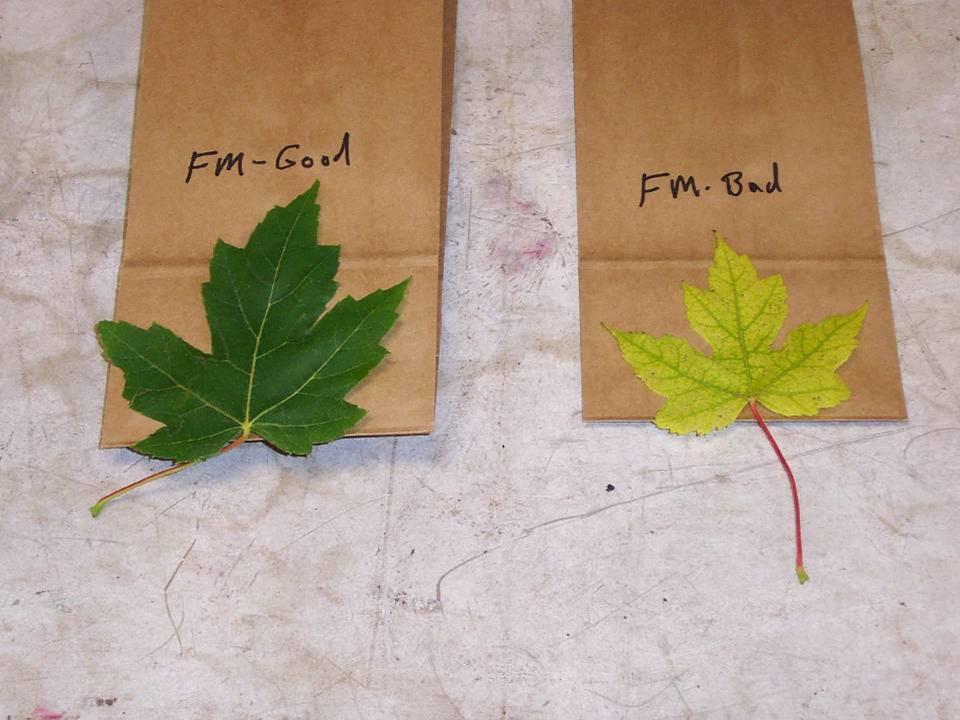As an Extension Specialist working with nursery and landscape issues, I’m frequently called upon to troubleshoot problems with trees and shrubs in various settings. Sometimes it’s residential or commercial landscapes, sometimes nurseries, sometimes Christmas trees. So naturally I was intrigued when the most recent issue of American Nurseryman featured a cover story on diagnosing nutrient deficiencies in plants. The article was written by Dr. Gary Gao, Extension specialist with Ohio State University. The article http://www.amerinursery.com/article-7428.aspx is good and does a good job on covering the basics. However, the introduction of the article also hit on one of my pet peeves – and what is the Garden Professors for if not to vent on our pet peeves.

The intro states:
"If you have a good understanding of the function of plant essential mineral elements and a familiarity with common symptoms, common mineral nutrient disorders can be diagnosed quite easily."
Maybe I’m just trying to justify my own existence, but I find diagnosing nutrient disorders anything but easy. This article and countless extension bulletins and factsheets imply that you can diagnose nutrient problems simply by matching leaves from your tree or shrub to a photograph showing the same symptoms. To which I have three words: Ain’t gonna happen. For the upper Midwest, I can think of exactly two landscape nutrition problems that I would be comfortable diagnosing by visual symptoms; iron chlorosis in pin oak and manganese deficiency in red maple. Beyond those two I would want information from foliar samples and soil tests, as well as some site information before concluding the cause of a plant problem.

The main issue, of course, is that plant problems rarely come gift-wrapped. Nutrient deficiencies (or, rarely, toxicities) are often confounded with other site issues; poor drainage, excessive drainage, too much sun, too much shade, insect damage, diseases, salt exposure. As I’ve said many times, it’s much rarer to find a ‘smoking gun’ than not. Usually it’s process of elimination with a best case scenario where you can compare symptom and foliar analyses of ‘good’ and ‘bad’ plants. But I think we do a disservice to landscape and nursery professionals and homeowners to imply that identifying the cause of a problem is as simple as picking the right suspect out of a line-up.
Great post, Bert! I concur with your peevage. And let me add a couple of points:
(1) Just because leaves are deficient in a nutrient does not mean the soil is also deficient in that same nutrient.
(2) Nutrient toxicities are quite common in urban soils and can create secondary deficiencies. For instance, phosphate toxicity in the soil can create an iron deficiency in leaves.
Agreed…. as a service forester I was often called upon to answer “whats twrong with my tree….). I came to hate the word blight. My experirnce is t
hat it is rarely one thing (smoking gun) that can be attributed to a tree health issue. It almosst always was a “syndrome” problem with me. Several circumstances (usually including a man induced few)could always be identified. My favorite diagnosis was “construction syndrome ” (closely related to what Walter would call ‘dumbass syndrome’) and “wrong tree in the wrong place”. For the life of me I can’t figure out why I’m not very popular. Lets face it even gypsy moths rarely ever killed trees of them selves. They usually either finished the job or initiated the process.
As a grad student who has studied nutritional disorders and seen the variation in symptoms, I agree and appreciate your clarification. Visual diagnosis is just one of the tools in a diagnostician’s toolbox.
Dr. Kim Coder spoke at the TX ISA conference last month about this very topic, pointing out that the exact same symptoms might mean either a surplus or a deficiency of a number of micros. Further, adding one nutrient might completely change availability of another. Takehome message for me was: mulch and compost correctly, choose the right plant, and let the soil take care of these little details.
Pesticide and other toxin damage can also mimic nutrient deficiency symptoms, per my arboriculture textbook, entitled, creatively enough, _Arboriculture_.